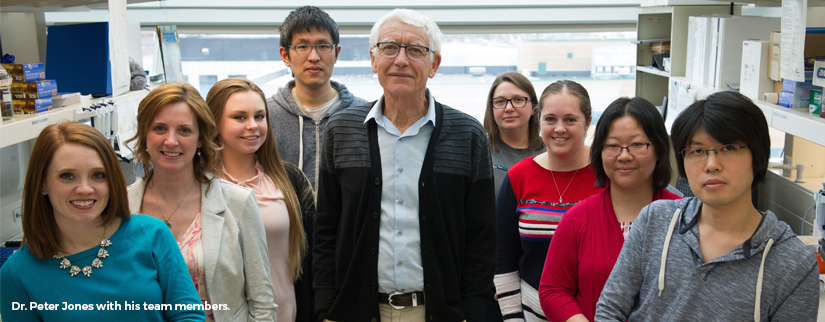VARI’s Chief Scientific Officer won an Outstanding Investigator Award. Here’s what that means.
June 14, 2017

VARI’s Chief Scientific Officer Peter Jones, Ph.D., D.Sc., has received a highly competitive 7-year, $7.8 million Outstanding Investigator Award grant from the National Cancer Institute to develop new epigenetic treatments for cancer.
The grant is designed to allow scientists with exceptional track records of success the opportunity to take greater risks, be more adventurous in their lines of inquiry, and take time to develop new techniques that might be more difficult to conduct using routine funding mechanisms.
This is a rare opportunity for Jones and Van Andel Research Institute to push the limits of biomedical research and capitalize on a body of work that started with Jones’ breakthrough discovery in 1980 that DNA methylation affects gene expression and cellular differentiation. It was the first time in medical science that someone had demonstrated the connection between epigenetics and cell function.
In the more than 35 years since that publication, Jones’s efforts have played a key role in the development and implementation of a new class of pharmaceuticals called hypomethylating agents, particularly
5-azacytidine, which have improved the lives of many people with myelodysplastic syndromes and acute myeloid leukemia.
Here are the questions Jones intends to answer with the new grant funding (as he wrote them in the application, with translations into English for the rest of us):
- Question: Why are there so many mutations in chromatin modifiers, and what are the effects of these mutations on the structure of the epigenome?
Translation: Our DNA has layers upon layers of control systems, and those systems play important roles in regulating our genes. How does this happen, and can the findings help us make better cancer drugs? - Question: What are the functional consequences of activating the expression of cancer/testis genes by 5-azanucleoside?
Translation: A lot of cancers suppress the body’s natural ability to fight tumors. But this drug that treats myelodysplastic syndrome (MDS) may be really good at reanimating the suppressed immune system. We want to test this hypothesis and report on the findings. - Question: What double-stranded RNAs are activated by 5-azanucleosides, and how do these relate to cellular responses?
Translation: That MDS drug we mentioned above—it alters the production of RNA. We’re going to find out exactly which bits of RNA the drug activates because other cancers could be treated with it, too. - Question: Can we design combinations of epigenetic drugs which might increase the effectiveness of 5-azanucleoside treatment?
Translation: Patients often benefit from combination therapies in which drugs perform better together, instead of individually. We want to test different combinations that can maximize the anti-cancer effects of epigenetic therapies. - Question: Can cryo-EM help to visualize complexes relevant to chromatin structure and functions?
Translation: Van Andel Research Institute recently installed one of the world’s most powerful microscopes in its David Van Andel Advanced Cryo-Electron Microscopy Suite. This super-powerful device can deliver images of the body’s functional proteins and chemicals within a few atoms of accuracy. We want to determine whether cryo-EM imaging can help us understand how DNA methylation works—and more importantly, how we might develop new cancer drugs based on the new knowledge.
